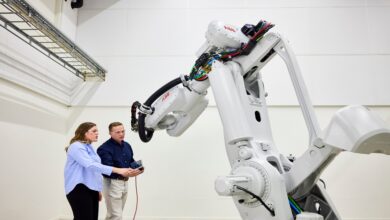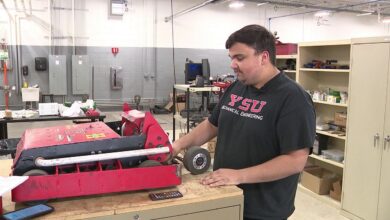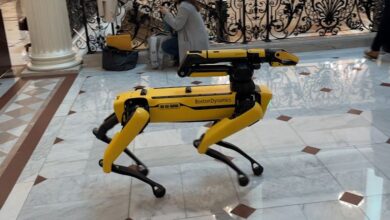Bota Systems Gives Robots the Sense of Touch – EEJournal

Let’s commence this column by performing a simple thought experiment. Suppose I were to give you a bolt and associated nut and tell you to hold one in each hand. Now suppose I were to tell you to screw the nut onto the bolt. In this case, your primary sensory apparatus would be your eyes, but other sensory modalities would also come into play.
For example, visualize bringing your hands together until the nut contacts the bolt, starting to rotate the nut clockwise, realizing that it’s requiring more force than you would expect, deducing that you’ve “crossed the thread,” backing off by rotating the bolt anticlockwise, and then attempting to perform the operation once more. It’s obvious that, although vision certainly plays a part, your sense of touch and your ability to detect force are also of tremendous importance.
A similar process is currently being played out in the world of robotics. When we hear about robots being equipped with advanced sensors, our knee-jerk reaction is to think about machine vision systems employing one or more CMOS sensor-based cameras augmented with artificial intelligence (AI) and machine learning (ML). It’s certainly true that, much like our biological sensorium, vision-based systems can provide a lot of very useful information, but vision alone may not be sufficient.
In the case of our nut and bolt scenario, for example, if our robot were relying solely on vision, it would fail to detect the possibility of a crossed thread and would carry on screwing regardless, with a high possibility of damaging the nut-bolt combo. Obviously, equipping our hypothetical robot with sophisticated force-sensing capabilities would be advantageous, but creating this type of sensor is not as easy as you might think.
I was just chatting with Ilias Patsiaouras, who is the Co-Founder and CTO at Bota Systems. Based on the rambling preamble above, it may not surprise you to learn that the folks at Bota are creating the most awesome force sensors for robots that you’ve ever seen (and that robots have ever felt).
SensONE Adapter Kit for Kinova Gen3 Robots (Source: Bota Systems)
As is often the case (at least, it’s often the case when I’m involved), Ilias and I initially wandered away from the primary purpose of our conversation when we made our introductions. As part of this, I discovered that Ilias started off with a mechanical engineering background, then he began to work with electronics systems, and he ended up as a master of mechatronics.
Just to ensure we are all tap-dancing to the same skirl of the bagpipes, as we read on the Wikipedia: “Mechatronics is an interdisciplinary branch of engineering that focuses on the integration of mechanical engineering, electrical engineering, electronic engineering and software engineering, and also includes a combination of robotics, computer science, telecommunications, systems, control, and product engineering.”
In his early twenties, Ilias was involved in a project that I would have given my eyeteeth to have been a part of—he worked at the National Technical University of Athens as a researcher for four years developing a “space simulator.”
“What’s a space simulator?” I hear you cry. It’s funny you should ask. “What’s a space simulator?” I asked Ilias. This is very cool. The idea is that, following orbital insertion, a satellite has a limited amount of fuel for its thrusters for orbital maintenance, maneuvering, and—eventually—deorbiting. What happens if a satellite uses up all its fuel? You end up with a very expensive piece of junk whizzing around the earth at thousands of miles an hour.
Ideally, it would be great if all future satellites were to be equipped with the same type of refueling access (the equivalent of a fuel cap on a car, but different), which would greatly ease the task of an autonomous refueling satellite that could come alongside and “top them up.”
I say “all future satellites” because, historically, every satellite manufacturer has gone their own way, sometimes going out of their way to reinvent the wheel, as it were.
Ilias describes his space simulator as being like a gigantic air hockey table with two “robots” floating around on cushions of air. The table itself was formed from a table of thick, heavy granite that was ground down to a smoothness (or roughness, depending on your point of view) of only 8 micrometers. The robots levitated 20 micrometers above the surface in what was effectively a zero-friction environment, essentially providing a 2D representation of 3D space. A “dead robot” drifting around represented the satellite needing fuel, while an “active robot” attempted to perform a docking maneuver.
Happily, Ilias managed to unearth (yes, of course “pun intended”) a video on YouTube of all this in action.
I could waffle on for yonks about the route Ilias took before eventually co-founding Bota Systems, but that would detract from the cool information I have to impart. In a crunchy nutshell, the robotic force sensors on the market a few years ago left a lot to be desired, so Bota Systems was formed with a mission to create the best robotic force sensors on the market.
Now, I don’t know about you, but I hadn’t previously given much consideration with respect to the problems associated with force sensing in this context, so what Ilias told me really opened my eyes. Suppose we have a robotic arm, and we wish to understand any acceleration components occurring at its wrist, for example. In this case, all we need to do is to attach a teeny-tiny 3-axis accelerometer in the form of a microelectromechanical system (MEMS) sensor, and “Bob’s your uncle” (or aunt, depending on your family dynamic).
The same thing applies to most other forms of sensor, including temperature, humidity, 3-axis gyroscopes, 3-axis magnetometers… the list goes on.
We can think of all the aforementioned sensors as being attached in a “sidecar” fashion, like a sidecar to a motorcycle, for example. (Saying this reminds me of the British cooking show Two Fat Ladies featuring Jennifer Paterson and Clarissa Dickson Wright, who were often to be found tooling around on a Triumph Thunderbird motorbike with a Watsonian “doublewide” sidecar).
By comparison, when you come to think about it, you realize that a force sensor must be mounted in an “inline” fashion. In the case of the junction between a robotic arm and its robotic hand, for example, we would have to cut the hand off at the wrist and insert our force sensor between the arm and the hand.
This has multiple implications. First, we want a 6-axis sensor that can measure both linear force (stretching and compressing) along the X-Y-Z axes and torque (the rotational analog of linear force) around the X-Y-Z axes.
Second, the sensor must be strong and robust (we don’t want our sensor to be the weakest link). Third, the sensor must be small (it’s hard to reach into a glass jar if you happen to be holding a bowling ball, for example). Fourth, the sensor must be light (it’s hard to be subtle in your finger gestures to other motorists if you are holding a 10-pound weight, for example). And, on top of all this, the sensor must be accurate and sensitive, and—depending on the targeted application—it must support a wide dynamic range capable of accommodating loads from a few grams to a hundred kilograms, or more.
So, no problem there, then. I’m joking—this is an incredibly tough nut to crack. Happily, this is where the guys and gals at Bota Systems score. They supply a selection of 6-axis force torque sensors created from the ground up with robotic applications in mind. These sensors come in a range of sizes, starting with the MiniOne weighing in at only 30g and measuring only 30mm x 23.2mm (diameter x length).
These low-latency sensors include all associated electronics, along with additional temperature and inertial sensors coupled with in-sensor sensor fusion that can recalibrate the main sensor and remove any drift in real-time.
All of this explains why Bola Systems is the 6-axis force torque sensor “purveyor of choice” for discerning research laboratories and leading-edge robotics companies around the world.
Furthermore, the reason for my waffling here is that the chaps and chapesses at Bola Systems recently announced their latest and greatest offering in the form of the PixOne, which can be summarized as “6-axis force torque sensor with integrated electronics that supports high torque, that’s reliable and robust, and that retrofits on your current robot (i.e., ‘Plug-and-Work’).”

PixONE sensor mounted on an industrial robot (Source: Bota Systems)
As we read in the press release:
PixONE is a cutting-edge through-hole sensor that integrates high-performance electronics within a compact, ultra-lightweight design. Designed for seamless integration into robotic systems, PixONE features a through-hole architecture facilitating internal cable routing to enhance robot agility and safety.
The PixONE sensor’s innovative hollow shaft design allows it to be seamlessly integrated between the robot’s arm and the end-of-arm tooling (EOT), maintaining the integrity of internal cable routing. This design is particularly advantageous as many robotic arm manufacturers are moving towards internal routing to eliminate cable tangles and motion restrictions.
PixONE’s minimalistic two-piece design not only simplifies assembly but also significantly reduces the sensor’s weight, making it 30% lighter than comparable sensors in the market. This is critical for dynamic systems, such as fast-moving robots, where excess weight can impede performance and operational efficiency.
Offered in various models with an external diameter starting at just 2.36 inches (60mm) and a through-hole diameter of 0.59 inch (15mm), PixONE includes an integrated Inertial Measurement Unit (IMU) and boasts a robust IP67 waterproof rating, making it suitable for a wide range of operational environments.
I couldn’t say this better myself, which is why I didn’t even try. I tell you; one of the great things about writing for EEJournal is that I get to meet folks from all sorts of companies, and I learn all sorts of new things. I certainly learned a lot talking to Ilias. How about you? Have you learned anything new by reading this column?
Related



